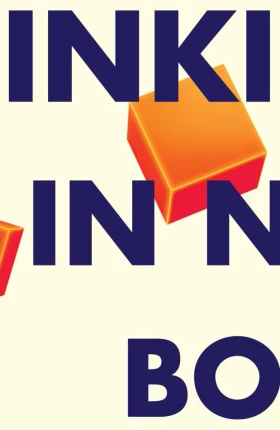Creativity in business is a conundrum: on one hand, creativity is more important than ever, given all of the information about how the world is changing at faster rates than ever before. The lifespan of a good idea is also shorter than ever. But, on the other hand, leaders across industries and around the world are frustrated with the traditional “outside the box, unconstrained, blue sky” approach.
In a live chat hosted on LinkedIn on June 5, 2014, Alan Iny, BCG’s senior specialist for creativity and scenarios and coauthor of Thinking in New Boxes, answered questions and gave concrete tips on bringing creativity to a range of business problems.
Creativity Means…
What is the difference between creativity and innovation?
Creativity is fundamentally about changing your perceptions, while innovation is about changing reality. When you innovate, you improve something to make it cheaper, or more colorful, or have more features. Creativity, by contrast, is about changing the way you look at the world, i.e., finding new boxes. That new point of view enables you to see new products or services, cut costs, refine processes, or redefine an entire industry.
The other key difference is that individuals are creative, while organizations innovate. One person cannot innovate, because you need a team, a group. The role of the organization is to provide the right environment for people to be creative—and, in an ideal world, innovation by the organization is what follows.
Creativity, from the Individual to the Organization
How do the tools to create ideas differ if they are used by only 1) one person, 2) a small group, or 3) a large audience?
One could argue that the fundamental tools are similar—doubt your preconceived notions; explore the world in front of you; diverge and then converge, etc. But, of course if you’re one person, it can be much harder.
One tool that I find works well for a single person (other than finding a couple of trusted friends to join you) is to try putting yourself in the shoes of someone else, or even yourself at a different time. How would I have tackled this problem on my first day out of university? How would my grandmother tackle it? How would the CEO of Apple tackle it? And so on.
I do prefer small groups in general if the goal is to solve a specific problem: you want some diversity. But as with individuals, changing perspectives and trying new combinations or analogies are really at the root of all of the infinite number of ways to run a creative exercise.
In all cases, though, being very clear about the problem statement and any criteria and constraints before you get into any brainstorming is actually a really good thing (in contrast to the general attitude of “we need an unconstrained session”). It makes the brainstorm somewhat harder, I concede, but it dramatically increases the probability of the output being useful.
How can you get a generally conservative industry to view a nagging problem differently when there are no trend-setting companies willing to lead the way?
It is easy to say we need to foster a climate of doubt, where people are willing to challenge their perspectives and look at things through fresh lenses. That’s step one, which many people often skip in the traditional “blue sky” brainstorm—and missing this step can practically ensure that the end result isn't great. But, if you’ve ever tried to get someone you love to lose weight or quit smoking, you understand that you cannot simply tell them to do so. You have to understand their rationale and incentives, and then appeal to that.
It’s the same in business: why is it that no one is willing to lead the way, to challenge the status quo? Is it because companies are making sufficient profits under the current system? Is it risk aversion? Is it because individuals aren’t willing to think about the long term? Or something else? Once you understand the underlying “boxes” driving the human beings who are at the center of the problem, you can begin to make progress.
There is a common conception that the “next big thing,” the disruptive solution that you are alluding to, comes from the likes of Zuckerberg in the dorm room, or Hewlett-Packard in the garage: and of course that’s anecdotally true! But I have a very firm belief that if people take the time to understand and thoughtfully challenge, or doubt, their existing “boxes,” then the next big thing can just as easily come from massive companies, like many of my clients. It just takes a willingness to challenge boxes such as “this has always worked for us” and “this is the way we do things around here.”
What are your thoughts on how—if at all—the creative process needs to be adapted to different contexts, such as the public and private sectors?
This is a great question. And of course, as a consultant, the answer is “it depends!” I believe that the five-step process outlined in Thinking in New Boxes applies to a wide range of problems: professional/personal, public/private sector, and so on. But I also very naturally have to tailor what I do to the specifics of the situation—getting someone to lose weight and getting someone to adopt a new strategy require different tactics!
But it really does boil down to mental models or “boxes,” though. If people at a certain Indian client, or Japanese client, have a different approach or way of doing things than my New York-based clients, then I need to adapt if I want to get the job done. The same holds when it comes to the public and private sectors. I’m about to overgeneralize significantly, but sometimes in the public sector the pace is different, the type of employee is different, the overall objectives are different, and so on. Differences exist among government agencies, family businesses, traditional corporations, nonprofits, and others. The key is to understand, to the extent possible, the “boxes” of the people you are dealing with, and then adapt and challenge them accordingly.
That last comment, incidentally, is one of the strongest arguments I’ve seen in favor of diversity in the workplace—and I mean diversity along as many dimensions as you can think of! Kant taught that we don't see the world as it is, we see the world as we are. That is, we each see the world through the lens of our own box or boxes. And so if you try to be creative with people who have a different academic background, work experience, ethnicity, gender or country of origin, so much the better because you’ll broaden the range of perspectives, which helps push people outside of their usual ways of thinking.
One more thought along those lines. One of my favorite stories is about BIC. It was founded as a pen company and was doing well as a pen company. You can imagine that if somebody told BIC employees to “think outside the box” they might propose ideas like four-color pens, erasable pens, or customized pens with a customer’s logo. But if someone came up with the idea of lighters or razors the reaction might be, “You’re crazy—we’re a pen company!”
Indeed, if you are boxed in by the idea that “we’re a pen company,” then lighters and razors are bad ideas. But consider what happens if you shift your “mental box” entirely and adopt a new outlook—something like, “we make disposable plastic items.” When you look at BIC’s business capabilities from the perspective of “plastic items,” lighters and razors are perfectly logical ideas, and they lead to expanding profits and revenues.
But what about the people at BIC? What had to happen in order to make that shift happen? Maybe the head of manufacturing needed to think about retooling the machines to make other plastic items. Maybe the head of sales needed to think about distribution channels. Maybe the CEO had a very emotional connection to the “pen company” box. My point is that even in a place where they held to the “we are a pen company” box, they came at it from different ways, and so to get them to make change happen, they had to be convinced in different ways, they had to come to the “new box” in different ways.
Also, just to be clear, I am well aware that it was reportedly the CEO of BIC, le Baron Bich himself, who had the original idea of moving beyond pens to disposable plastic objects. He was open to new boxes in a way that not all CEOs are!
Shifting “Boxes” and the Role of the CEO
Could you explain your unequivocal statement “no idea is good forever”?
The logic behind that statement is as follows: our mental models or boxes change periodically, in a step function sort of way; for example, we see movement from “we are a pen company” to “we are a disposable plastic items object company,” or from “our strategy is x” to “our strategy is y.” But the world changes gradually, sometimes faster and sometimes slower, and it doesn’t stop. And so by definition, any one of our boxes will at some point be out of date. And hence no idea is good forever, not Ford's Model T, not the iPhone, not penicillin, not anything else. It’s just a question of when.
Which leads me to a thought exercise I often try with my clients: imagine a perfectly run company in which everyone in every department is doing his or her job well. In that case, what is the job of the CEO?
My answer is simply that the job of the CEO, then, is to determine what the next “new box” should be, and when. The timing is critical. For example, if the people who created YouTube had done so five years earlier, it would have flopped, since most people didn’t have access to a lot of bandwidth on their computers and devices. But if they had come up with it five years later, we’d be calling it something else—since someone else would have come up with the idea first.
Managing Creativity in Practice
How do you balance creativity with the aims of operational excellence?
This is a beautiful and very practical question! Of course we should all think creatively, we should all challenge our perspectives, we should all think in new boxes. But we still must face earning pressures, day-to-day activities, and so on.
One part of my answer goes back to BIC again: when the company shifted to lighters and razors, it didn’t stop making pens—indeed the pens continue to be an important part of their revenues 40 years after their new box emerged! And so the point, within the creative process, is to balance both the incremental and the transformational, since they can both be valuable. Think of the first iPhone: it was relatively transformational and money-making; but the subsequent generations are arguably less transformational but very money-making.
But the question is also broader—it’s not just about incremental versus transformational creativity; it’s creativity versus operational goals. And the best answer I have is balance. We need to balance inductive and deductive thinking. We need to balance left brain and right brain, thinking and doing, however you want to phrase it. The balance will tilt in different directions at different points in the business cycle—and different people will be more comfortable with different sides of the equation. But in all cases it’s about balance.
That’s also why so many of the great partnerships—such as Hewlett-Packard, Gates and Allen, Rolls and Royce—generally feature people with different approaches and different strengths. To really succeed in business, I believe all of us need a bit of both.
What are the most common mistakes that companies or even managers are making that inadvertently stifle individual creativity?
The opposite of mistakes, I think, are companies that allow individuals to “speak truth to power”—to disagree with someone regardless of hierarchy—are off to a good start. They should value ideas regardless of where those ideas come from. They should methodically source ideas from a lot of different places, and give everyone (or almost everyone) room to experiment.
Not fearing failure can make you more creative—but is it a very practical approach?
Linus Pauling (who won two Nobel prizes, so he should know) said that the best way to have a good idea is to have a lot of ideas. This is logically true as well. Simply by the law of large numbers—whatever the criteria you set for a “good idea”—if you have a lot of ideas, you’ll have a lot of average ones and some lousy ones as well.
Even BIC, which had such phenomenal success with lighters, razors, and now disposable mobile phones (part of their “disposable plastic items” box) has also had some failures—I don’t think disposable plastic underwear or surfboards went over very well.
Again, for most of us it will come down to balance. If one goes to the extreme in terms of not fearing failure, then one might occasionally come up with something disruptive, do very well, and become famous. Last week I was speaking at a conference with Richard Saul Wurman, who founded TED and is the person furthest along that no-fear-of-failure spectrum I have ever met. But more likely, you will not become famous or change the world. Which is why for most of us, a healthy skepticism, a healthy dose of doubt, is a much more practical approach.
Can you give examples of how companies encourage creativity by rewarding so-called good failures?
Let me start by saying I agree that this kind of culture is critical to fostering a culture of creativity, one in which failure is not punished if it is the result of a thoughtful creative process.
One company that does this is LEGO (like BIC, the company likes its name to be capitalized). Its CEO has said that people should be rewarded not for failure, but for failure to help when asked, or for failure to ask for help. My friend and colleague Yves Morieux talks a lot about them in his exploration of cooperation and simplicity in organizations—but of course it’s relevant to creativity as well.
Another illustrative example is to think about R&D in the pharmaceutical industry. If a scientist spends years on a compound that ultimately doesn’t make it through the funnel of clinical testing and the like, that generally doesn’t torpedo her career; it’s seen as a natural part of the process. Can tech companies, consumer goods companies, and others say the same?
In Conclusion
Would you say that today’s companies are in a period of great creativity—or a period of great creative crisis?
My answer is simply “yes!” Like many questions (especially in social media), this is a false dichotomy.
To elaborate: there is certainly a lot of world-changing creativity taking place, but we need more of it. Whenever old ideas come into contact with a new world, or a new environment, it creates conflict and potentially a creative crisis. A good example is sustainability and climate change. There is certainly a “creativity crisis” there—caused by conflicting perceptions and outdated assumptions that are not keeping up with a changing world.
Some people just say, “Well, we’re just not sure yet about the science,” and use that as an excuse for not responding. Of course we’re not 100 percent certain that the earth will be uninhabitable in five years or ten years or twenty. Yet the problem has more to do with mental models and creativity. We are not doing enough to question current belief systems and to open ourselves up to new possibilities, which would help us be better prepared for whatever the future may bring.
There are many more of those types of crises where old mental “boxes” are no longer useful and need to be replaced to better fit a changing world. So it’s a crisis—but also a moment where things are changing faster than ever before, and hence there are a lot of new possibilities out there.





